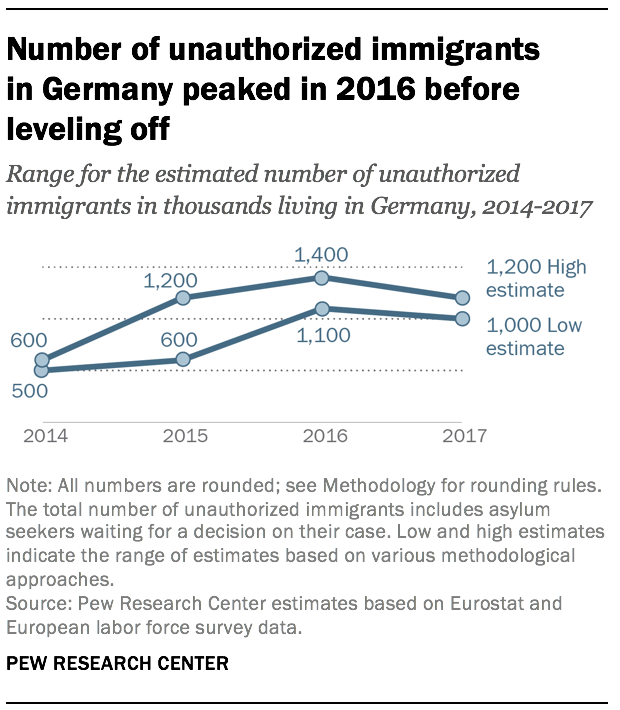Below are specific findings about unauthorized immigrants in Germany. The findings come from a Pew Research Center report about unauthorized immigrants in Europe.
An estimated 1.0 million to 1.2 million unauthorized immigrants lived in Germany in 2017, up from 500,000 to 600,000 in 2014, according to new Pew Research Center estimates based on the latest available data. The 2017 estimate includes 444,000 asylum seekers who were waiting for a decision on their case at the end of that year.
Germany’s unauthorized immigrant estimate accounts for roughly a quarter of the estimated 3.9 million to 4.8 million unauthorized immigrants living in the 32 European Union and European Free Trade Association (EFTA) countries at the end of 2017. The total number of unauthorized immigrants living in EU and EFTA countries is also up since 2014, when it stood at 3.0 million to 3.7 million.
Unauthorized immigrants are non-EU-EFTA citizens who entered Germany without permission and face obstacles to permanent residency. The population also includes those who may have entered lawfully but overstayed a visa. Asylum seekers waiting for a final decision in their case are also included in the unauthorized immigrant population estimates since their future status is uncertain – most entered Germany without authorization and face high rejection rates.
In Germany, those granted Duldung, a temporary protection from deportation (some 166,000 at the end of 2017), are also considered part of the unauthorized immigrant population in the Center’s estimate. Those with subsidiary protection, however, are not considered unauthorized immigrants. Although many in this group entered the country without authorization and were not granted refugee status, many have a path to longer-term permanency in the country.
Additional findings for Germany
- The number of unauthorized immigrants living in Germany reached a high of 1.1 million to 1.4 million in 2016, before leveling off to an estimated 1.0 million to 1.2 million in 2017. Part of the reason for the rise is the high number of asylum seekers working through the asylum process since 2016.
- In 2017, unauthorized immigrants made up about one-in-five (19% to 21%) of all immigrants with non-EU-EFTA citizenship (4.2 million to 4.4 million) living in Germany. Roughly 1% of Germany’s total population were unauthorized immigrants in 2017.
- About one-third (32%) of unauthorized immigrants living in Germany in 2017 were from European countries outside the EU and EFTA. Three-in-ten (30%) had nationalities from the Middle East-North Africa region, and close to a quarter (22%) were from the Asia-Pacific region.
- About two-thirds (66%) of unauthorized immigrants living in Germany in 2017 had lived in the country for less than five years. Many of these more recent arrivals were asylum seekers awaiting a decision on their application for asylum.
- The majority (60%) of unauthorized immigrants in Germany were male in 2017. Nearly two-thirds (65%) of unauthorized immigrants in Germany were under 35 years old.
Pew Research Center estimates for Germany’s unauthorized immigrant population used the “residual” method, an indirect way to estimate the size of this population. It is the same method used by the Center in the United States to estimate the size of its unauthorized immigrant population.
The Center’s estimates for Germany are similar to those published elsewhere. A separate 2014 study estimated 180,000 to 520,000 unauthorized immigrants lived in Germany in 2014, not including asylum seekers waiting for a decision on their case. The Center’s estimate for the same year was 300,000 to 400,000 without asylum seekers, within the range of this other estimate. Our 2017 estimate for Germany of 600,000 to 700,000 unauthorized immigrants excluding asylum seekers is in line with expected trends given the high level of migration in 2015 and 2016.
For more information about the unauthorized immigrant population in Germany or other EU-EFTA countries, see the Center’s full report.
